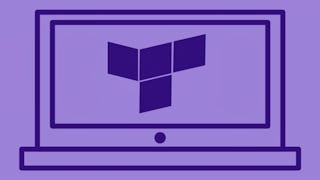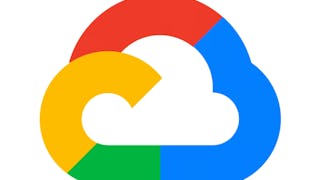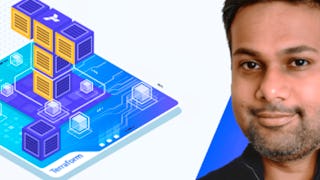本课程介绍如何在 Google Cloud 中使用 Terraform。学员将亲身实践使用 Terraform 构建和管理 Google Cloud 资源。


您将学到什么
确定基础设施即 Code 的业务需求以及在环境中使用它的好处。
解释 Terraform 的特点和功能。
使用 Terraform 资源、变量和输出值创建 Google Cloud 基础架构资源。
使用 Terraform Module 构建可重复使用的配置。
要了解的详细信息

添加到您的领英档案
5 项作业
了解顶级公司的员工如何掌握热门技能

该课程共有7个模块
本部分欢迎学员参加 Google Cloud Fundamentals:核心基础架构课程,并概述课程结构和目标。
涵盖的内容
1个视频
这是一个介绍性模块,涵盖 Terraform 的业务需求。我们将从基础知识开始,概述基础设施即代码(IaC),这是 Terraform 的基本概念。我们将探讨如何在 Google Cloud 上将 Terraform 用作 IaC 工具,还将介绍其功能和优势。然后,我们将了解 Terraform 如何将代码行转化为 Google Cloud 上真正的基础设施。
涵盖的内容
5个视频1个作业
在本 Module 中,我们将向您介绍 HashiCorp 语言,并讨论编写 Terraform 配置所涉及的术语和概念。我们还将探讨管理 Terraform 配置所涉及的一些重要 Terraform 命令。完成本模块后,你将能解释每个代码块的含义,在 Terraform 中创建基本配置文件,并能解释几个重要 Terraform 命令的用途,我们还将探讨什么是 Validator 工具。
涵盖的内容
9个视频1个作业1个应用程序项目
在本 Module 中,您将探索更多有关资源、变量和输出资源的内容。我们将首先探索如何使用资源创建基础架构组件,然后探索 Terraform 如何处理资源中的依赖关系。虽然我们一直在介绍通过使用硬代码资源参数创建资源,但我们将探索如何使用变量对给定配置进行参数化。我们将探讨在配置中声明、定义和使用变量的语法。然后,我们将讨论如何使用输出值在资源声明之外输出资源属性。最后,我们将了解如何使用 Terraform 注册表和云计算基础工具包简化代码编写。
涵盖的内容
10个视频1个作业1个应用程序项目
您将了解什么是 Modulation、如何从公共注册表中使用它们、如何使用模块重用配置,以及如何使用输入变量对配置进行参数化。您还将了解如何使用输出值访问模块之外的资源属性。
涵盖的内容
8个视频1个作业1个应用程序项目
Modulation 首先介绍 Terraform 状态。然后,你将了解 Terraform 状态的不同存储方式。本模块稍后将探讨将状态文件存储在远程位置的好处。虽然有许多远程位置可以存储状态文件,但本模块将介绍如何将其存储在 Google Cloud Storage Bucket 中。本模块最后将介绍使用状态文件的最佳实践。
涵盖的内容
6个视频1个作业1个应用程序项目
在最后一节,我们将回顾本课程的内容。
涵盖的内容
1个视频
位教师

提供方
从 软件开发 浏览更多内容
 状态:免费试用
状态:免费试用
Google Cloud
 状态:免费试用
状态:免费试用 状态:免费试用
状态:免费试用
人们为什么选择 Coursera 来帮助自己实现职业发展




学生评论
56 条评论
- 5 stars
71.92%
- 4 stars
22.80%
- 3 stars
5.26%
- 2 stars
0%
- 1 star
0%
显示 3/56 个
已于 Jul 28, 2024审阅
It gave me good understanding of terraform and how to use it, thank you all.
已于 Aug 29, 2022审阅
Decent course. However for $50, I was expecting more.
已于 Nov 25, 2024审阅
This course is really Awesome to get familiar with the Terraform and its components. I would strongly recommend if anyone wanted start to know about Terraform with GCP.
常见问题
要获取课程资料、作业和证书,您需要在注册课程时购买证书体验。 您可以尝试免费试听,或申请资助。课程可能提供 "完整课程,无证书"。通过该选项,您可以查看所有课程资料,提交必要的评估,并获得最终成绩。这也意味着您无法购买证书体验。
购买证书后,您就可以访问所有课程资料,包括已评分的作业。完成课程后,您的电子证书将添加到您的 "成就 "页面--您可以从那里打印证书或将其添加到您的 LinkedIn 个人资料中。
是的。在特定的学习课程中,如果您付不起注册费,可以申请助学金或奖学金。如果您选择的学习课程有助学金或奖学金,您可以在说明页面找到申请链接。
更多问题
提供助学金,



